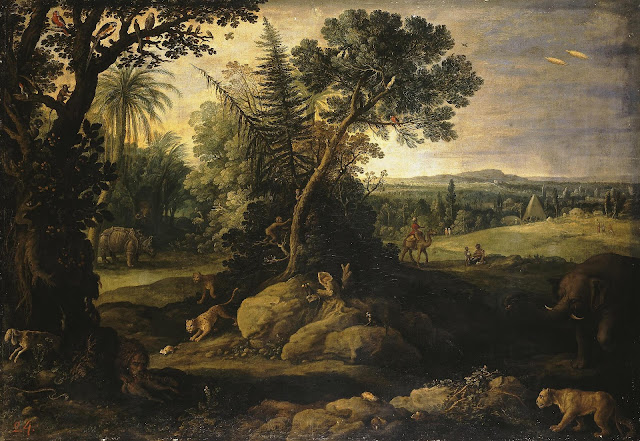 |
| Claude Lorrain (Rome) Coast view with Apollo and Cumaean Sibyl ca. 1645-49 oil on canvas Hermitage, Saint Petersburg |
 |
| Claude Lorrain (Rome) Landscape with Rest on the Flight into Egypt 1661 oil on canvas Hermitage, Saint Petersburg |
"The combined effect of Claude's oeuvre is one of endless variation on a number of basic themes. To comprehend his paintings to the full we could envisage a great museum containing all his works, for the internal correspondences between his pictures are more important than in the case of Annibale Carracci or Poussin. Naturally individual buyers never envisaged such an assembly. And today it would be more difficult than ever to achieve, when even pairs are no longer together. But the artist himself saw his work in a context of continuity, in the shape of the Liber veritatis. Here he could survey his themes and variations, his changes and innovations in a demonstration that became increasingly an end in itself."
"Let us imagine that we are wandering round in this imaginary museum. Apparent likenesses – touches of the similar laid over obvious differences – help to stimulate recognition, while we also continuously encounter refreshing and surprising novelties. The discontinuities – we never return to exactly the same place or the same occasion – induce lapses of memory. Surely this way, with the great leafy plants and fragments of ancient capitals half buried in the earth, this path that I recently followed – did it not lead to a bridge, or was it the shady approach to a temple? But now there is open water close by, and cattle can be glimpsed over there as the light glances over their forms."
 |
| Claude Lorrain (Rome) View of Campagna di Roma from Tivoli 1645 drawing Hermitage, Saint Petersburg |
 |
| David Teniers (Flanders) Temptation of St Anthony ca. 1650-55 oil on canvas Hermitage, Saint Petersburg |
 |
| David Teniers (Flanders) Landscape with Tower ca. 1645 oil on canvas Hermitage, Saint Petersburg |
 |
| David Teniers (Flanders) Mountainous Landscape 1640 oil on panel, transferred to canvas Hermitage, Saint Petersburg |
 |
| Nicolas Poussin (Rome) Venus, Faun and Putti ca. 1635 oil on canvas Hermitage, Saint Petersburg |
"We know that Poussin used to build models of the world he was going to depict, with clay figures and a box-like stage. Here the characters were placed in groups and lit from the left. His approach to pictorial devices thus closely resembled conceptions of stage design. He may have applied this method mainly to history painting, but even his landscapes show signs of rigorous design and structuring in a shallow box-like space."
"Claude Lorrain's ideal landscapes are built on somewhat different lines. Here the force of attraction exerted by the light, its expansive power, creates a vibrant, pulsating world. The figures are too tiny and the space too vast for the spectator to imagine himself looking at a constructed stage. In this meeting between painted characters and spectators the 'actors' do not seem to be performing before an audience able to identify with the events depicted and to learn from them, so much as offering bridges or reference points to the emotion that is immanent in the pictured space."
 |
| Gaspard Dughet (Rome) Landscape with Milvian Bridge ca. 1645-50 drawing Hermitage, Saint Petersburg |
 |
| Jacques d'Arthois (Flanders) Landscape with Herd ca. 1660 oil on canvas Hermitage, Saint Petersburg |
 |
| Gerard ter Borch (Netherlands) Carriage in a Landscape before 1681 wash drawing Metropolitan Museum of Art, New York |
 |
| Lucas Achtschellinck (Flanders) Landscape with Flight into Egypt ca. 1650-1699 oil on canvas Hermitage, Saint Petersburg |
"In the fictitious natural world depicted in the ideal landscape there is movement and direction. Events take place most clearly, most rapidly and with the greatest intensity in the foreground, where identifiable characters appear; their fates provide one vehicle for our involvement. A hierarchy of value obtains, whereby the actions of individual but representative characters of mythology or history rank highest; at a greater distance from ourselves in the pictorial world animals and groups of anonymous figures engage in various activities. Signs of direction and movement are also visible in trees, in water and clouds. Trees with a suggestion of activity in their branches and leaves appear at every level in the picture, testifying to nature's own life somewhere between conscious and unconscious being – trees are vegetation, but they are also dominating figures, expressive, involved."
– from Ideal Landscape by Margaretha Rossholm Lagerlöf, translated from Swedish by Nancy Adler, published by Yale University Press in 1990
 |
| Mozes van Wtenbrouck (Netherlands) Landscape with Temple of Vesta before 1646 etching Rijksmuseum, Amsterdam |
 |
| Paul Brill (Flanders) Landscape with Exotic Animals before 1626 oil on canvas Hermitage, Saint Petersburg |
 |
| Abraham Bloemaert (Netherlands) Landscape with Tobias and the Angel ca. 1610 oil on canvas Hermitage, Saint Petersburg |